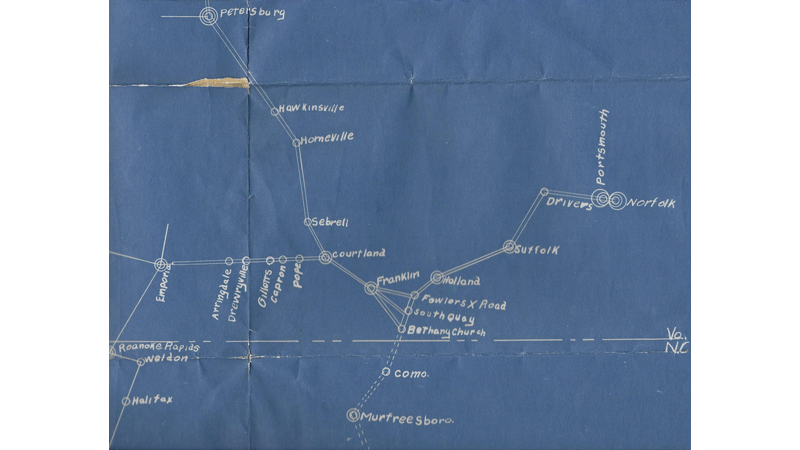Southampton’s concrete roadway
Published 11:45 am Friday, November 25, 2022
|
Getting your Trinity Audio player ready...
|
On Saturday, Nov. 4, 1922, Southampton County had a big day – the first big celebration since the memorable celebration, in Franklin, of the end of the World War in 1918 (later referred to as World War I). The current celebration: the official opening of the new 22-mile concrete roadway through Southampton County, reaching from Franklin on the southeast to the Sussex County line on the northwest. The road route passed through Courtland and Sebrell to “Sussex Gate” – a barrier to traffic which would pass away when Southampton, with the rest of the state, was to go under the provisions of the Stock Law on Jan. 1, 1923 when it would no longer be necessary to keep Southampton cows and pigs from wandering into the neighboring county of Sussex.
Although the world war was over, the people of Southampton were still experiencing much of the bitter of its aftermath in drastic deflation of all kinds. The people had been missing good old public celebration days. A few weeks earlier, upon a suggestion from Franklin Town Manager H. L. Beach and the town commissioners, plans were put in motion for another good old-fashioned community gathering. William Thomas Pace was made chairman of the executive committee to perfect arrangements for the day; and, with a number of efficient committee heads, all selected for their especial talent for the work they were to do, plans were made and carried out with a degree of absolute success which left nothing lacking in the aforementioned celebration.
The Franklin-to-Sussex concrete road, a great thing for that time, replaced gravel and dirt roadways which varied from muddy to dusty depending on the weather. It was a major segment of the Norfolk-to-Richmond “super” highway (called the “Ridge Route”) which was proposed and designed by General C. C. Vaughan, Jr. of Franklin. It was made possible by the issuance of $227,000 in bonds by Southampton’s Jerusalem District two years ago.
On celebration day, the festivities began with an automobile parade to the Sussex County line, headed by Sol W. Rawls, Sr., chairman of the parade committee, and John A. Lesner of Norfolk, president of the Tidewater Automobile Association. Also in the parade line were General C. C. Vaughan, Jr., of Franklin, president of the Virginia Good Roads Association; Franklin Mayor Claude J. Edwards; W. T. Pace, of Franklin, event chairman; and Southampton County Supervisor C. C. Vaughan, Sr., of the Franklin District. Many cars from Franklin, Courtland and Sebrell joined in the parade to the Sussex line. After assembling at Sussex, the parade returned to Franklin for a gathering at Franklin Athletic Field, behind the newly built Franklin High School. There, the speaking began.
Speakers included Maurice G. Long, of Norfolk, who spoke on the material benefits to be derived from good roads — economic, esthetic, social; John R. Hutcheson, Director of the Extension Division of Virginia Polytechnic Institute, who spoke on the need for farmers to increase productivity through crop diversification and the benefits to be derived through cooperative marketing associations; and Honorable Harris Hart, Superintendent of Public Instruction for the Commonwealth of Virginia, who spoke on the strong alliance between “good roads” and education — “Better roads mean better schools”, he said.
The most interesting and attention-getting part of the festivities were the livestock exhibitions held on the athletic field grounds. In charge, were Dr. W. E. Snipes and Dr. J. C. Rawls.
Cows were on display. Paul D. Camp showed-off two Guernseys and four Holsteins; Paul Ryland Camp — one Jersey and one Holstein; William M. Bradshaw — one Jersey, two Guernseys, and three Holsteins — all of them heavy milkers. One Holstein in Paul Camp’s herd was noted for giving ten gallons of milk per day.
Besides the cows, there were a number of fine hogs on exhibition. Dr. J. C. Rawls had two pens of fine Berkshires; M. A. Thomas, of the Thomas Duroc Ranch near Courtland, showed a 650-pound Duroc-Jersey boar; and Ritchie and Rainey of Petersburg brought in a pair of fine Durocs.
And there were some dogs. R. P. Rawls had some setter pups on display, Dr. J. C. Rawls showed-off several beagles, and P. D. Camp proudly presented a pair of fox hounds.
A dinner was held in the evening. Plates were piled high with Old Virginia barbecue, Southampton County ham, pickles, bread, etc. The American Legion served hot coffee free to all comers. A large fruit cake, baked by “Titus of Los Angeles”, was shipped in from California.
Clifford A. Cutchins, Jr. was chairman of the decorations committee whose good work was evidenced by all of the flags, bunting, and pennants adorning residences and business houses throughout the town.
Clyde Parker is a retired human resources manager for the former Franklin Equipment Co. and a member of the Southampton County Historical Society. His email address is magnolia101@charter.net.






